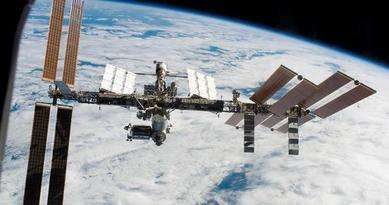CAPE CANAVERAL, Fla. (AP) — Spacewalking astronauts hooked up fancy new batteries Friday on the International Space Station’s sprawling power grid.
NASA reported that all three lithium-ion batteries were up and running, a successful start to the space agency’s long-term effort to upgrade the aging solar power system.
Before venturing out, Commander Shane Kimbrough and Peggy Whitson got a hand from a robot that took care of most of the grunt work — Dextre, a hulking machine with 11-foot arms.
Remotely operating Dextre outside the 250-mile-high lab, flight controllers in Houston spent the past week replacing decade-old, nickel-hydrogen batteries with the new ones. Handling all those batteries — each about half a refrigerator in size — was cumbersome and time-consuming.
On Friday, it was up to Kimbrough and Whitson to wire up three of the six new batteries delivered last month in a Japanese cargo capsule. The two made fairly quick work of it.
“I’m on a roll, right?” Kimbrough asked Whitson halfway through the job. The two were so far ahead that they tackled some extra work.
“I look forward to doing it again,” Kimbrough told Mission Control as the 6 1/2-hour spacewalk drew to a close.
Kimbrough and French astronaut Thomas Pesquet will plug in three more batteries next Friday. NASA expects it will take two to three years to change out all 48 nickel-hydrogen batteries that make up the station’s solar power system. The lithium-ion batteries are so efficient that only 24 will be needed, saving space for other items during supply runs.
The batteries store power that is tapped whenever the orbiting outpost is on the nighttime side of Earth.
Dextre, the station’s robotic handyman, removed the old batteries and popped in the new ones in a series of maneuvers that began on New Year’s Eve. The robot also loosened bolts on metal attachment plates for the new batteries, saving the spacewalkers even more time.
Starting Sunday, Dextre will be back at it, paving the way for next Friday’s spacewalk.
NASA’s chief astronaut, Christopher Cassidy, said from Mission Control that sticky bolts often stymie astronauts, so everyone was grateful to turn over the chores to Dextre, short for dexterous.
Spacewalks are high-risk activities, NASA managers noted, and so reducing crew time outside is always preferable. Almost as a reminder, Mission Control’s main contact for the spacewalkers was Italian astronaut Luca Parmitano, who nearly drowned in 2013 when his helmet flooded with water from his spacesuit’s cooling system. He directed Kimbrough and Whitson’s every move, and praised them for “an awesome job.”
Most of the old batteries will be junked along with other station trash in a month, burning up in the atmosphere along with the Japanese supply ship that delivered the new batteries.
Whitson now ties the record for most spacewalks by a woman — seven. At 56, she’s the world’s oldest and most experienced spacewoman.
Copyright 2024 The Associated Press. All rights reserved. This material may not be published, broadcast, rewritten or redistributed.

